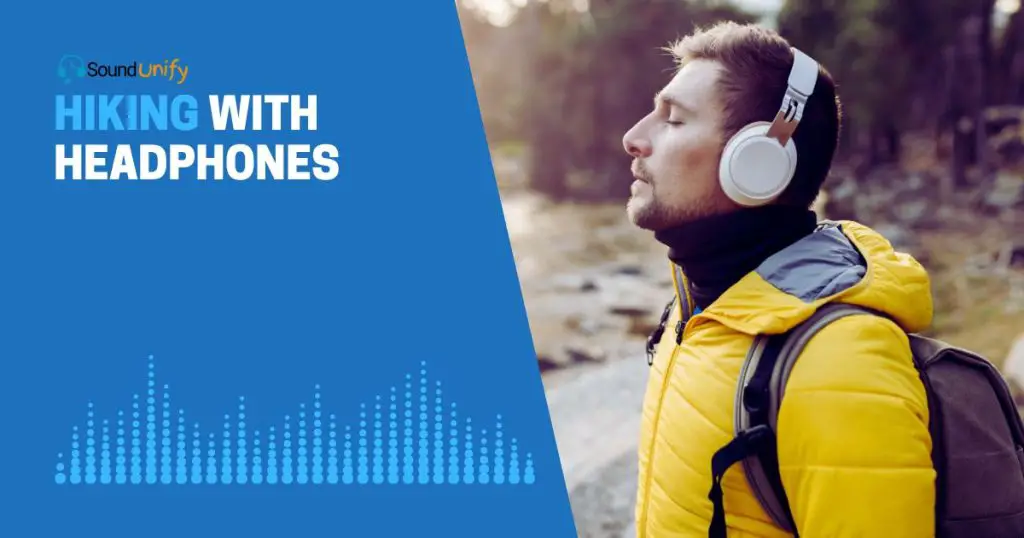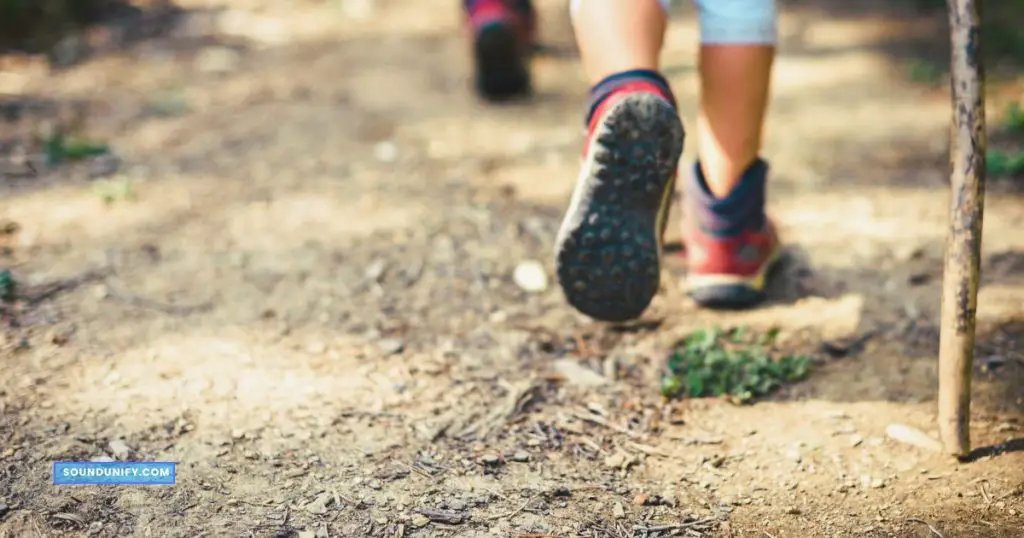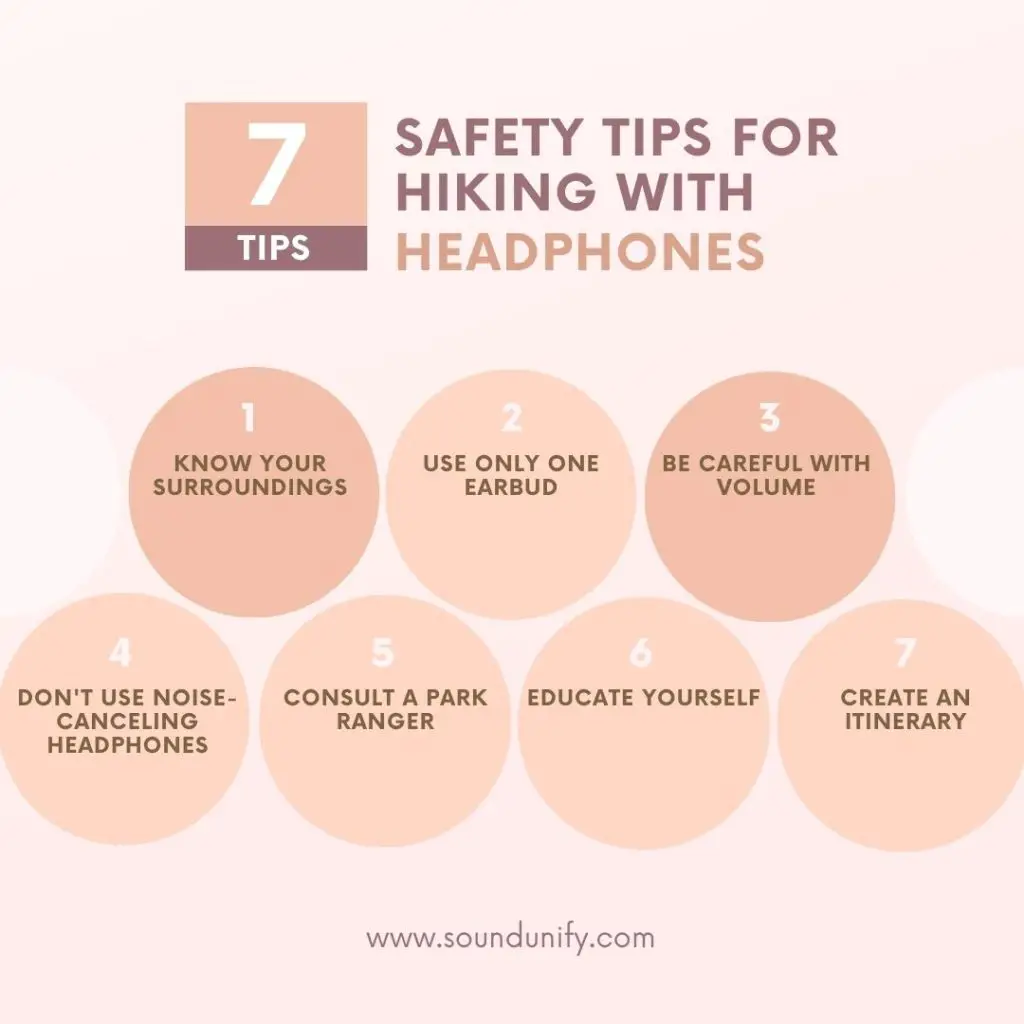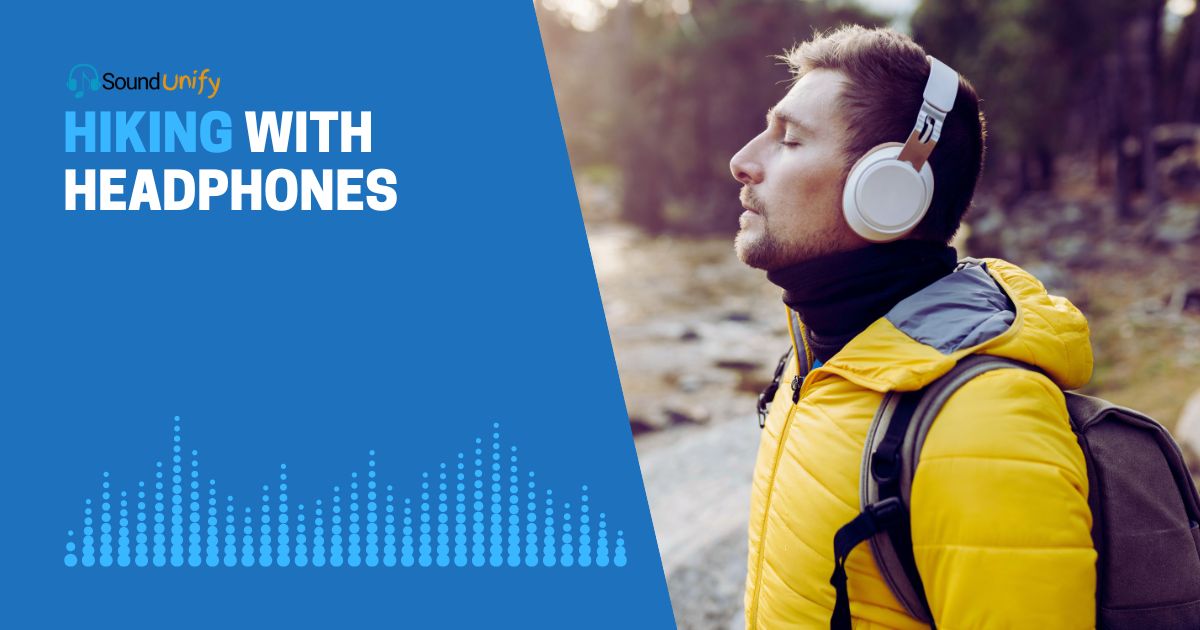Hiking with headphones can transform your trail experience into an immersive journey. It's the perfect blend of nature's symphony and your favorite tunes. But is it a good idea? Let's dive in.
I’ve always found solace in the rhythm of my boots crunching on a gravel path, the whispering wind through the trees, and birds chirping. But there are days when I crave a different soundtrack for my adventures.
That’s when I reach for my headphones. Yet, this simple act opens up a world of questions. Is it safe? Does it disconnect us from our surroundings? And most importantly, how can we balance our love for music with our respect for nature?
In this blog post, I’ll share my experiences and insights on hiking with headphones. We’ll explore the pros and cons, safety tips, and how to choose the right headphones for your outdoor escapades.
So, lace up your hiking boots, and let’s hit the trail together.

Is It Safe to Listen to Music While Hiking?
When hiking, I often find myself torn between wanting to listen to my favorite tunes and staying alert to my surroundings. You might have the same dilemma. So, is it safe to listen to music while hiking? The answer isn’t a simple yes or no. It depends on various factors.
Factor 1: Awareness of Surroundings
Firstly, my safety on a hike largely depends on my awareness of the surroundings. If I’m blasting music in my ears, I might not hear an approaching animal, a fellow hiker’s warning, or the sound of a falling rock. In such cases, listening to music can compromise my safety.
Factor 2: Type of Trail
The type of trail I’m on also matters. The risks associated with listening to music are lower on well-marked, busy trails. But on isolated, rugged trails, I need all my senses to navigate safely.
Factor 3: Volume and Type of Music
The volume and type of music I listen to can also impact my safety. If the music is loud, it can mask important sounds. Fast-paced music might also distract me and cause me to misstep.
Factor 4: Use of Headphones
If I use headphones, especially noise-canceling ones, they can significantly reduce my ability to hear external sounds. One workaround is to use open-ear headphones or to keep one earbud out.
Factor 5: Personal Skills and Experience
My skills and experience also come into play. If I’m an experienced hiker, I might be able to listen to music while hiking safely. But if I’m a beginner, staying fully alert is better.
Here’s an expanded summary:
| Factor | Impact on Safety |
|---|---|
| Awareness of Surroundings | High |
| Type of Trail | Medium |
| Volume and Type of Music | Medium |
| Use of Headphones | High |
| Personal Skills and Experience | High |
8 Benefits of Hiking with Headphones

Hiking is a popular outdoor activity that allows individuals to connect with nature and reap numerous health benefits. At the same time, some purists advocate hiking in silence to immerse oneself in the surroundings fully.
There are several benefits to incorporating headphones into your hiking experience.
1. The Power of Music
Music isn’t just a form of entertainment; it’s a powerful tool influencing our physical and emotional state.
According to a study by the University of Nevada, Reno, music can reduce stress, improve mood, and enhance physical performance. When I’m hiking, my headphones allow me to harness this power.
- Motivation: The right song can push me to tackle that steep hill or go that extra mile.
- Pace: The rhythm of the music can help regulate my hiking pace, making the hike more efficient.
- Mood: Music can lift my spirits, making the hike a more enjoyable experience.
2. Motivation
When I hit the trails, my headphones are as essential as my hiking boots. They’re not just an accessory; they’re a tool for motivation. Here’s why:
- Music fuels perseverance: The beat of a good song keeps me moving, even when the trail gets steep.
- Rhythm regulates pace: Matching my steps to the rhythm helps maintain a steady hiking pace.
- Lyrics inspire: Inspirational lyrics can turn a challenging hike into a rewarding personal journey.
- Audiobooks engage the mind: Engaging my mind with an audiobook or podcast can make a long hike seem shorter.
- Nature sounds enhance the experience: Sometimes, I play nature sounds to feel more connected to the environment.
3. Block out Distractions
In the heart of nature, you’d think distractions would be minimal. But even on the trail, unwanted noise can intrude.
Chattering hikers, distant traffic, or even the buzz of a pesky insect can pull me out of my hiking groove. That’s where my headphones come in.
They help me control my auditory environment, allowing me to focus on the hike and fully immerse myself in the experience.
4. Mood Enhancement
Music has a profound impact on our emotions. Unsurprisingly, it plays a significant role in enhancing my mood during hikes.
- Uplifting tunes: Listening to upbeat music can make me feel happier and more positive.
- Relaxing melodies: Conversely, slow, calming music can help me unwind and enjoy a leisurely hike.
- Personalized playlists: I tailor my playlists to my mood, the trail, and the weather, creating a personalized hiking soundtrack.
5. Feel More Adventurous
With my headphones on, every hike feels like an adventure. The right song at the right moment can transform a simple walk into an epic journey.
It’s like having a personal score for my hiking movie, where I’m the star. Whether exploring a new trail or revisiting a favorite spot, my headphones excite the experience.
6. Stress Reduction
Hiking is a great stress reliever, but adding my headphones into the mix takes stress reduction to a new level.
- Mindful meditation: Listening to guided meditations or calming music can help me achieve a state of mindfulness. It’s just me, the trail, and my breath.
- Escape from reality: My headphones offer an escape from the daily grind. For a few hours, it’s just me and my music, lost in the beauty of nature.
- Boosts mood: As mentioned earlier, music can significantly enhance mood, reducing stress and anxiety.
7. Improve Your Balance
This might surprise you, but wearing headphones while hiking can improve your balance.
- Focus on the trail: With my headphones blocking out distractions, I can focus more on the trail and my footing.
- Rhythm and coordination: Moving in time with the music can improve coordination and, by extension, balance.
8. Learning Opportunity
Lastly, hiking with headphones provides a unique learning opportunity.
- Audiobooks and podcasts: I often listen to audiobooks or educational podcasts during my hikes. It’s a great way to learn something new while enjoying the outdoors.
- Language learning: I’ve even used my hiking time to practice a new language through audio lessons.
- Nature sounds: Listening to recorded nature sounds can help me become more attuned to the real sounds around me, enhancing my understanding and appreciation of the natural world.
Why Don’t You Go Hiking with Headphones?
While I’ve previously discussed the benefits of hiking with headphones, it’s important to consider why one might choose not to. Here are some key points to consider:
1. Decreased Awareness
When hiking, I find immense joy in immersing myself in the rhythm of my footsteps and the beauty of nature.
However, I’ve noticed that wearing headphones can significantly decrease my awareness of my surroundings. This decreased awareness can pose a real issue.
For instance, the sounds of nature, such as the rustling of leaves, the chirping of birds, and the distant murmur of a waterfall, all contribute to the enriching experience of hiking.
With headphones on, I might miss out on these auditory delights. More importantly, I might also miss warning signals.
Not hearing a biker’s warning shout or the rustling of a bear in the bushes due to my music could lead to dangerous situations.
2. Disturbance to Wildlife
As an animal lover, one of the aspects I enjoy most about hiking is the opportunity to observe wildlife in its natural habitat. However, it’s important to consider that our music can disturb these creatures.
Animals generally have a sharper sense of hearing than we do, and the sound of our music can scare them away or provoke them.
By playing loud music, we’re potentially disturbing the natural balance of the wilderness.
3. Potential for Accidents
Safety is always my top priority when I’m hiking. But, when I’m wearing headphones, I’ve noticed that I’m more prone to accidents.
Music can distract me, causing me to lose focus on the trail. Additionally, if my music is too loud, I might not hear the warning calls of other hikers or the sounds of potential danger, like a falling rock.
4. Missing Out on Nature’s Soundtrack
Part of the joy of hiking for me is connecting with nature, and part of that connection comes from the sounds of the wilderness.
With headphones on, I might miss out on nature’s symphony: the chirping of birds, the rustling of leaves, and the sound of a flowing river – all of which contribute to the overall hiking experience.
Moreover, the sound of music can disrupt the peace and tranquility that come from being in nature.
5. Decreased Interaction
Hiking is often a social activity, and wearing headphones can make me seem unapproachable, decreasing my interaction with fellow hikers.
Headphones can be a social barrier, making me seem unapproachable to other hikers.
This could lead to missed connections, as I might miss out on making new friends or learning from other hikers’ experiences.
7 Safety Tips for Hiking with Headphones

When hiking with headphones, it’s important to prioritize safety to ensure an enjoyable and secure experience. Here are seven essential safety tips to keep in mind:
1. Know Your Surroundings
When I’m out hiking, I always make sure to familiarize myself with the trail and my surroundings. This is even more important when you’re wearing headphones. Here’s why:
- Trail Knowledge: Before you even put your headphones on, take a good look at the trail. Are there any potential hazards you should be aware of? Are there any steep drops, slippery surfaces, or unstable rocks? Knowing the trail can help you anticipate potential dangers.
- Awareness of Others: Trails are often shared spaces. Bikers, runners, and other hikers could be on the same path. Being aware of them can help prevent accidents.
- Wildlife: Depending on where you’re hiking, there might be wildlife to consider. Knowing what animals are in the area and how to react if you encounter them is crucial.
2. Use Only One Earbud
One trick I’ve learned is to use only one earbud while hiking. This allows me to enjoy my music or podcast while keeping one ear free to listen to the sounds of nature. Here’s why this is beneficial:
- Balance of Sound: Using one earbud allows you to enjoy your audio while still hearing the sounds of nature and any potential warning sounds.
- Safety: Keeping one ear free increases your safety as you are more likely to hear approaching people, animals, or potential hazards.
3. Be Careful with Volume
I can’t stress enough how important it is to be mindful of your volume when hiking with headphones. Here’s why:
- Hearing Hazards: If your music is too loud, you might not hear the warning calls of other hikers or the sounds of potential danger, like a falling rock.
- Preventing Hearing Damage: Prolonged exposure to loud music can lead to hearing loss. It’s best to keep the volume at a safe level.
4. Don’t Use Noise-Canceling Headphones
I love my noise-canceling headphones for long flights or busy coffee shops, but they stay at home when it comes to hiking. Here’s why:
- Blocked Sounds: Noise-canceling headphones create sound waves that cancel out external noise. This is great for blocking out the hum of an airplane engine but not so great when you need to hear a warning shout or the rustle of an animal in the underbrush.
- Reduced Awareness: With all external sounds blocked, your awareness of your surroundings is significantly reduced. This can be dangerous when hiking, as you might not hear a mountain biker coming up behind you or the warning call of another hiker.
5. Consult a Park Ranger
Before I set off on any hike, I always make it a point to consult a park ranger. They’re a wealth of knowledge and can provide valuable information about the trail and potential hazards.
- Trail Information: Park rangers have the most up-to-date information about trail conditions. They can tell you if recent rainfall might make the trail slippery or if a section has been washed out and is impassable.
- Wildlife Information: Park rangers can also provide information about the local wildlife. They can tell you if there have been recent bear sightings in the area or if there’s a nest of hornets on the trail that you should avoid.
6. Educate Yourself
I believe that education is key when it comes to hiking safely. This is especially true when hiking with headphones.
- First Aid Knowledge: Knowing basic first aid can be a lifesaver in case of an accident. I always refresh my knowledge before setting off on a hike. This includes knowing how to treat minor injuries like cuts and sprains and what to do in case of more serious injuries.
- Trail Etiquette: Understanding trail etiquette ensures a positive experience for you and other trail users. This includes knowing when to yield the trail to others, how to minimize your impact on the environment, and how to interact with wildlife.
7. Create an Itinerary
Before starting a hike, I always create an itinerary and share it with someone I trust. This is more than just deciding which trail I’m going to take.
- Safety Measure: An itinerary lets others know where you’re going and when you plan to return. If something happens and you don’t return when expected, having someone know your plan can be crucial for your safety.
- Plan Your Hike: An itinerary helps you plan your hike, including breaks, to manage your time effectively. It also lets you plan your hike around the weather and daylight hours.
What Makes A Great Headphone For Hiking?
Choosing the right pair is crucial for bringing headphones on your hiking adventure. Not all headphones are created equal, especially for outdoor activities like hiking. Here’s what I look for in a great pair of hiking headphones:
1. Durability
Hiking can be tough on gear, and headphones are no exception.
- Weather Resistance: I look for headphones that are water and sweat-resistant. This is especially important if I get caught in a rain shower or work up a sweat on a challenging trail.
- Robust Build: The headphones should be well-constructed and withstand the occasional drop or bump.
2. Comfort
Comfort is key, especially on long hikes.
- Fit: The headphones should fit well and not cause discomfort over time. I prefer over-ear hooks for a secure fit, but everyone’s preferences and ear shapes differ.
- Weight: Lighter headphones are less likely to cause discomfort or fatigue over long periods.
3. Battery Life
I don’t want to worry about my headphones dying on me when I’m out on the trail.
- Long Battery Life: I look for headphones with a battery life that can last through my longest hikes.
- Quick Charging: If the headphones can charge quickly, that’s a big plus. Some headphones offer several hours of playtime after just a few minutes of charging.
4. Sound Quality
While I don’t expect concert hall quality on the trail, I still want my music, podcasts, or audiobooks to sound good.
- Clear Sound: The headphones should deliver a clear, balanced sound.
- Noise Isolation: Some degree of noise isolation is beneficial, but complete noise cancellation might not be safe on the trail as it can block important environmental sounds.
5. Safety Features
Safety is paramount when hiking, and headphones can contribute to that.
- Ambient Sound Mode: Some headphones allow ambient noise to pass through so that I can stay aware of my surroundings.
- Volume Limiting: Headphones that prevent dangerously high volume levels can protect my hearing.
FAQs
1. Is it safe to run outside with headphones?
Yes, it can be safe to run outside with headphones, but it’s important to remain aware of your surroundings. Keep the volume where you can still hear ambient noises, like approaching vehicles or people. Also, consider using open or semi-open headphones that allow some external sound.
2. What temperature is bad for headphones?
Extreme temperatures, both hot and cold, can be harmful to headphones. Cold temperatures can make certain parts of the headphones brittle, while hot temperatures can cause internal components to overheat. As a rule of thumb, if it’s a temperature you’d be uncomfortable in, it’s likely not good for your headphones.
3. Is it okay to hike with headphones on?
Yes, hiking with headphones on is okay, but staying aware of your surroundings is crucial. This is especially important when hiking, where you might encounter wildlife or need to hear other hikers’ warnings. Consider using headphones that allow you to hear ambient noise and keep the volume at a level where you can hear what’s happening around you.
4. Does music improve hiking performance?
Music can indeed enhance your hiking experience by boosting your mood and motivation. However, it’s important to note that everyone is different. While some people may find that music helps them hike faster or longer, others may prefer the peace of nature. It’s all about personal preference.
5. Should I hike with one earbud in?
Hiking with one earbud is a good compromise that allows you to listen to music while being aware of your surroundings. This is especially useful in areas where you must be alert for wildlife or other hikers.
6. What should I include in my hiking playlist?
Your hiking playlist should include music you enjoy and motivate you. Some people prefer upbeat, energetic music to keep them moving, while others might prefer calm, relaxing tunes. Consider songs with a good rhythm to match your walking pace. Ultimately, the best hiking playlist makes the journey more enjoyable for you.
Final Thoughts
Hiking with headphones? A unique experience. Nature’s Symphony, replaced by my playlist. The rhythm matches my steps. But I miss the birdsong. The rustling leaves go unheard.
Still, the music fuels me. It’s a trade-off, indeed. A solitary journey amplified by melodies. Yet, the wilderness whispers are lost. It’s a choice: nature’s tune or my own.
James Dimento is a Chief-in-Editor of SoundUnify. He is a headphone enthusiast and creative writer passionate about audio technology. He has three years of experience writing about headphones and sound quality and is responsible for creating reviews and taking care of all administration.
